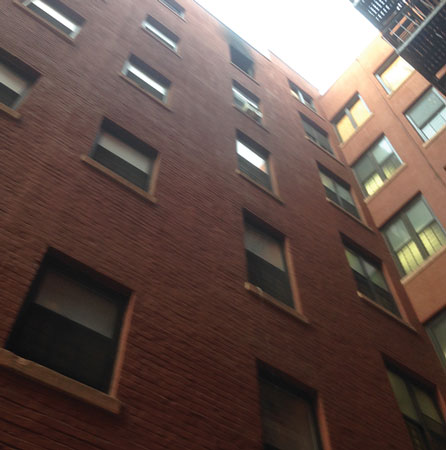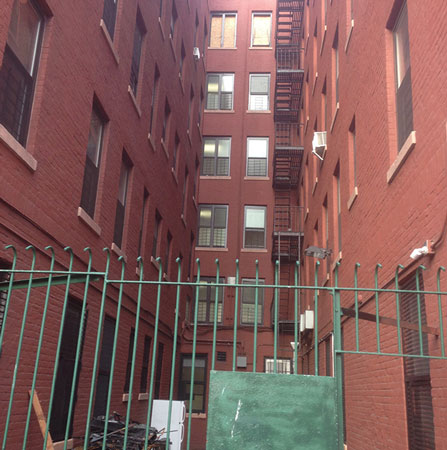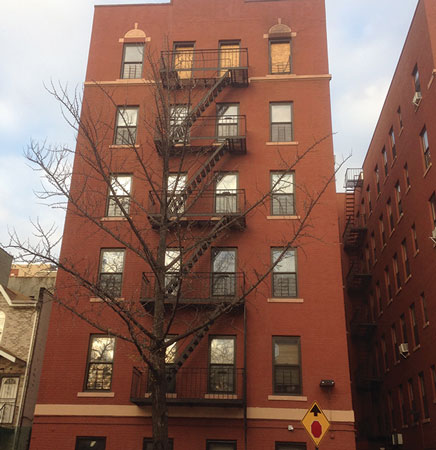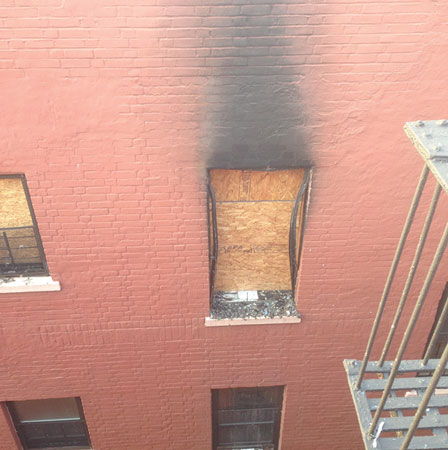
BY DAN SHERIDAN
How do we take all the information we receive from an alarm ticket and translate that data into a strategy? In a department as large as the Fire Department of New York, we depend heavily on our standard operating procedures (SOPs) to assist the incident commander (IC) in managing the incident. Units, depending on their order of assignment and the type of structure, are expected to follow the department’s SOPs. When everyone is on the same page, the operation is safer and more efficient.
 |
| (1) Photos by author. |
Initial Dispatch
When the department receives a call for a fire, the battalion chief (BC) will try to gather as much information as possible before and as he responds to the incident. The BC will immediately try to get the address of the incident, and hopefully this will bring an image of the building to mind. I can generally get a good idea of the building and the street based on the address given. As the house watch calls out the information to the units, everyone assigned should begin sizing up the situation based on their roles. Let’s take the following response ticket as an example:
UCT911-1st Alarm-Residential
E001 E002 E003 L001 L002 BC01Box 2280-755 Longview Ave
E150 St Longview Ave
E=Mult Dwell A
Apt 6d 6Flr/Apt On Fire
CIDS:
Rehab MD 6Sty 100×100 CL3LW C
Joist Floors Large Apts Irregular Shape
A Stair Serves Apts A-D B Stairs E-H
No Roof Access On Exp 4 Side Rope Stretch Poss
Incident #0977FDID: 16345-2280-02-2-0917
12/10/16 195724
Based solely on the response ticket information and with no other data at our disposal, we already know 12 of the 13 points of the traditional size-up memory aid, COAL WAS WEALTH. Combining the dispatch data with our knowledge of the building from prior experience, the BC would feel pretty confident going in on this alarm.
- Construction: Class III (ordinary), lightweight, nonfire-resistive.
- Occupancy: multiple dwelling.
- Apparatus and equipment: three engine and two ladder companies.
- Location: possibly the sixth floor.
- Water supply: hydrants on East 150th Street and Longview Avenue.
- Area: 10,000 square feet.
- Street conditions: wide, two-way street in front.
- Weather: heavy rain.
- Exposures: similar building on the exposure 4 side.
- Auxiliary appliances: none.
- Life hazard: unknown at this time.
- Time: 1957 hours.
- Height: six stories.
Sometimes, the dispatcher provides the units responding with any additional information received – e.g., a fire on the top floor, people trapped, and so on. Receiving information from a second source tends to confirm that something is happening at this box; firefighters can anticipate that this will probably be a legitimate call and not a false alarm. There is a correlation between the validity of the information received and the responding firefighters’ physiological reaction.

Each unit will continually do its own size-up based on the information received and its specific function/order of response on the ticket. Generally, the companies respect each other’s right to be first due. This is a tremendous asset for the first-due BC (the IC). The IC can now develop a strategy without any surprises and have a more orderly operation, saving time and effort and getting the water on the fire more quickly. When companies respect each other’s response ticket order of arrival, it enables the units to work together more cohesively instead of competing for the first line. All engines must strive to get that first hoseline in place before stretching any other hoselines. The following is a synopsis of the thought process that should be expected of the first-alarm units.
Response Considerations
Engine 1 is first due, so its officer and the engine operator should consider apparatus placement and the location of the available hydrants on the block. On this assignment, they know that Longview Avenue is a wide, two-way street (photo 1) and there should be no issues with taking the hydrant directly in front of the building.
The other Engine 1 firefighters are aware that the building is very large and the fire is probably on the top floor, which will require a very long stretch. The last firefighter on the stretch will be responsible for providing the required amount of hose for the stretch and will remain at the hosebed until the hose is broken and attached to the outlet.

Based on the information from the dispatch ticket, the firefighters will be using the rope to stretch. Engine companies store 75 feet of rope in a bleach bottle for use in large buildings where applicable. One important task for the officer is to determine the fire apartment layout; checking the apartment directly below it is a great way to accomplish this.
Engine 2 will be second due and will work with the first-due engine in stretching and getting that first hoseline in operation. The Engine 2 engine operator will look for another functioning hydrant to serve as a backup to the first engine. The Engine 2 officer will become the water resource officer and will ensure that the first hoseline is supplied. Among his other duties, this officer must control the number of firefighters on the fire floor and be a communications link between the first-due engine officer and the IC. Engine 2 members will try to conserve their self-contained breathing apparatus air so that they will be ready to relieve the first-due engine (the nozzle team) when needed.
Engine 3 is responsible for stretching a second backup hoseline to the fire area that will serve as a safety line if the water supply is lost or will be used to address any fire extension to an adjoining apartment or the cockloft. It is mandatory: If one line is stretched and operating, stretch a second line.
The Engine 3 officer and the engine operator should discuss the location of another hydrant that is on a different water main than the hydrants that the first two engines are using. The Engine 3 firefighters should ensure that the first hoseline is in operation before stretching the second line.

Ladder 1’s officer and the chauffeur should discuss apparatus placement, which depends on the location of the fire in the building. The inside team will perform the critical task of locating the fire before anything else and communicate this to the IC and the first engine officer. In a building of this size, it is imperative that the officer communicate with the engine officer as to the fire’s location before they commit to a stairway. The last thing an engine wants to do is stretch up the wrong stairway.
The officer will be responsible for transmitting certain information to the IC, who needs to get as much information as possible to help develop his strategy. The acronym LO DANCE is a good way to quickly recall what needs to be transmitted.
- Location.
- Occupants accounted/unaccounted for.
- Delays or Difficulties in entry.
- Access, the best route to the fire.
- Number of apartments on the floor/wing.
- Conditions in the apartment or on the fire floor.
- Extension to the floor above.
The items above are extremely important to an IC, who may be in front of the building and can’t get a full picture of what’s happening upstairs. In a smaller private dwelling, an IC has the luxury of doing a 360° walk-around. In a larger building, the IC relies on his first-due ladder to provide him with as much data as possible.
The inside team makes its way to the door of the fire apartment, attempts to gain entry, performs a primary search, and confines the fire until the engine can get a hoseline in place. The officer will be responsible for all ventilation in the fire apartment, much of which is based on control of the apartment door.
Ladder 2 will be assisting Ladder 1 on the top floor. Usually with a top-floor fire, the smoke condition will be heavy, so the two companies search the other apartments on the top floor and check for possible extension through the cockloft. The outside team assists the first team in roof operations and venting from the fire escape outside the fire apartment. Ladder 2’s chauffeur will position the apparatus to cover any part of the building that Ladder 1 can’t.

The BC should be listening to the department radio carefully trying to glean as much additional information as possible. He has two concerns with these types of alarms: (1) ensuring all the first-alarm engines work together to get that first hoseline in operation before stretching any other hoselines; and (2) a fire in the common cockloft, which requires a tremendous amount of resources to contain it. In formulating his plan, the IC initially focuses on the following items: locating the fire, life, preventing fire spread, confining the fire, ventilation, extinguishment, and searches.
The first engine arrives and transmits the signal for a working fire: “Engine 1 to dispatch, working fire on the top floor of a six-story multiple dwelling.” On receiving this transmission, the dispatcher fills out the rest of the alarm with an additional engine, a rescue, a squad, a rapid intervention team, a BC, and the deputy chief. The first battalion arrives and transmits the signal, “All Hands,” and requests an additional engine and ladder. Just as if the units were following a script in a play, each unit goes to work based on its order of assignment.
Once Engine 1’s lieutenant receives confirmation from Ladder 1 that the fire is on the top floor, he grabs the bleach bottle from the cab and instructs his crew that they will be stretching the hoseline by the hallway windows on the exposure 2 side (photos 2-3). This will reduce the stretch from 12 lengths to about six.

The nozzle firefighter follows the officer into the building to the window on the floor below the fire. The rest of the firefighters bring the hose to the base of the window, waiting for the deployment of the rope. Engine 2 arrives and assists Engine 1 with the stretch.
Ladder 1 makes its way up to the top floor and meets a heavy smoke condition; the fleeing occupants (encountered on the floor below) left the door open. An occupant of the fire apartment assures the officer that everyone got out. The lieutenant does a quick count of the apartment doors on the fire floor and finds only four doors, indicating that each apartment is large, and transmits all this information about his findings to the IC as follows:
- The fire is on top floor, exposure 2 side (photo 4).
- The occupants are accounted for.
- There are no delays or difficulties.
- The best access is by the exposure 2 side stairway.
- The fire floor has four apartments.
- The fire apartment door is open.
- Fire has not extended to the cockloft; I will inform you if it does.
Using the aerial ladder, Ladder 1’s outside team makes its way to the roof with the saw and begins its operations. They let the IC know the following:
- The building configuration is an H type (photo 5).
- Fire is out the windows on the exposure 2 side in the shaft (photo 6).
- Heavy black smoke is pushing from other windows.
- No persons are trapped.
- No access is possible to the adjoining building from the roof.
- No fire is in the cockloft at this time.
Ladder 2 assists Ladder 1 on the top floor and begins to search the common hallway and the adjoining apartments for any persons trapped and for any fire extension in the cockloft. The outside team goes to the roof and the fire escape to assist in ventilation and in vent-enter-isolate-search of the fire apartment.
Engine 3 sees that the first line is in operation, so it starts a second line to the top floor.
When the BC arrives on the scene, most of the tactics that must be initiated are already in progress. The chief now has to monitor the progress of the operation based on the reports he is getting and on his own observations. The fourth engine will assist Engine 3 with its hoseline. The rescue and squad can assist on the roof and on the top floor with the searches and checking of exposures. The extra engine and ladder will be at staging, ready to relieve first-alarm units or to operate in an exposure. The rapid intervention team will remain at the command post, ready to deploy if necessary.
The key to success at this and at any operation is that the information was available and disseminated to the troops in a timely fashion. Most of the guesswork was taken out beforehand because of the response ticket information and the prior knowledge and experience of the responding officers and firefighters. The dispatch ticket gave everyone responding an opportunity to review it and apply it to the incident at hand. This particular operation was a success because everybody operated from the same sheet of music, combined their efforts, and worked for the greater good.
DAN SHERIDAN is a 30-year veteran of the Fire Department of New York, where he is a battalion chief. He has worked in Harlem and the Bronx for most of his career. He is a national instructor and the founder and chief operating officer of Mutual Aid Training Group.
WRITING STANDARD OPERATING PROCEDURES AND GUIDELINES
The Downside of Overusing Dispatching Technology
Handling the Mayday: The Fire Dispatcher’s Crucial Role
Fire Engineering Archives

